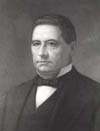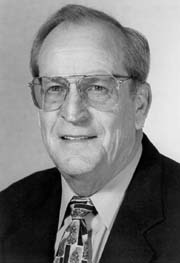|
|
|
|
|
Chapter 162 of the Acts of 1825 was passed adopting a plan for public education that divided each county into districts and distributed the cost per child among taxpayers; six counties voted not to adopt the measure, postponing a statewide system of public education (Brugger, 251). |
1825 | General Assembly creates the first Board of Public Works to fund internal improvement projects (dissolved in 1828). |
|
U.S. government opens a naval school at Fort Severn, Annapolis. |
1845 | - |
|
The C & O Canal reaches Cumberland and becomes a profitable conveyor of Western Maryland flour, wheat, and corn. Maryland's white literacy rate is about 5 percent.
|
1850 | - |
|
Second state constitution is adopted for Maryland (June 14). In addition to the office of comptroller, the new constitution creates commissioners of public works and lotteries, and county commissioners. State senators' terms are shortened from six years to four years. Maryland's Whig party begins decline.
|
1851 | Office of comptroller established for a four-year term to exercise
"general superintendence of the fiscal affairs of the State."
Origins of the office of Comptroller of Maryland. Overview of the current fuctions of the Comptroller of Maryland. A new Board of Public Works is created by the new constitution.
|
|
Lotteries a major revenue source - $55,358 (5.8% of Total Revenue) Licenses collected by Clerk of Circuit Court: Marriage, Fines & Forfeitures, Billiard Tables, Brokers,’ Wood Hucksters, Hawkers and Peddlers, Fishery, and Oyster House. Baltimore & Ohio Railroad lines reach Wheeling, Virginia by December, linking the Chesapeake Bay and the Ohio River by rail lines. Roman Catholics in Baltimore seek state funds for parochial education.
|
1852 |
Philip Francis Thomas qualifies for office and begins work on February 24, serving until April 20, 1853. Thomas' office is in the State House. The comptroller's office remains in the State House until 1859 when the Record Office building is constructed. See History of the Offices Occupied by Maryland's Comptrollers of the Treasury |
|
Allegany County coal miners and limestone workers in Baltimore County strike for more pay. Textile workers in Harford County and iron workers in Western Maryland
Baltimore, Carroll, and Frederick Railroad organizes, later became Western
Maryland Railroad.
|
1853 |
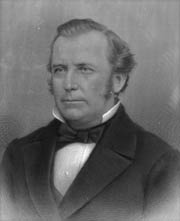 Henry
E. Bateman becomes the second comptroller of Maryland and serves from
April 20, 1853 to January 11, 1854. Henry
E. Bateman becomes the second comptroller of Maryland and serves from
April 20, 1853 to January 11, 1854.
Philip
Francis Thomas, Comptroller v. Jas. S. Owens, Treasurer, Court
of Appeals, 4 Md. 189 is decided in June by the Court of Appeals
to settle a dispute over salary payments to the comptroller.
|
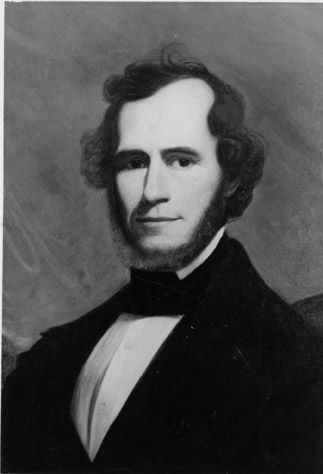 Thomas
Watkins Ligon becomes governor and serves Thomas
Watkins Ligon becomes governor and serves
from 1854 to 1858. Rise of Know-Nothing Party (1854-59). Baltimore riots named city "Mobtown."
|
1854 |
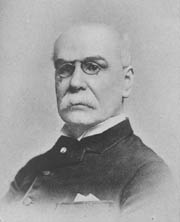 William
Pinkney Whyte becomes the third comptroller of Maryland and serves
from January 11, 1854 to January 9, 1856. William
Pinkney Whyte becomes the third comptroller of Maryland and serves
from January 11, 1854 to January 9, 1856. |
| Baltimore City elections erupt in violence between Know-Nothings and Irish Democrats. | 1856 |
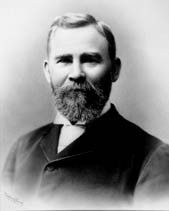 William
Henry Purnell becomes the fourth comptroller of Maryland and serves
from January 9, 1856 to May 8, 1861. William
Henry Purnell becomes the fourth comptroller of Maryland and serves
from January 9, 1856 to May 8, 1861. |
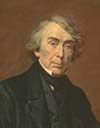 U.S. Supreme Court Chief Justice Roger B. Taney writes opinion for the
Dred Scott case.
U.S. Supreme Court Chief Justice Roger B. Taney writes opinion for the
Dred Scott case. |
1857 | - |
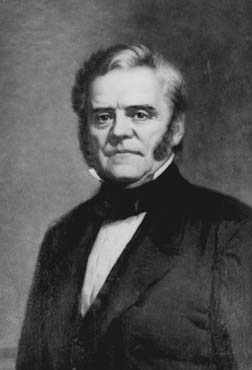 Thomas
Holliday Hicks becomes governor and serves from 1858 to 1862. Thomas
Holliday Hicks becomes governor and serves from 1858 to 1862. |
1858 |
Matilda E. Green vs. Wm. H. Purnell, Comptroller of the Treasury, Court of Appeals of Maryland, 12 Md. 329 is decided July 20, 1858, that defines the legal parameters of the office of comptroller in more precise terms. |
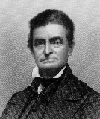 John Brown launches raid from Maryland on federal arsenal in Harper's Ferry,
West Virginia (October 16).
John Brown launches raid from Maryland on federal arsenal in Harper's Ferry,
West Virginia (October 16). |
1859 |
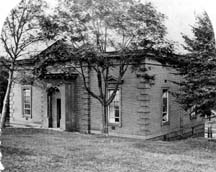
The Record Office (Land Office) Building is constructed on State House Hill behind the Old Treasury Building. The comptroller's office remains here until 1903. MSA SC 2246-3.
|
|
Lotteries are discontinued in Maryland Bounty Tax is instituted to pay Civil War volunteers. |
1860 |
The Maryland House of Delegates passes Resolution No. 6 on March 10, 1860, declaring the previous elections void in Baltimore due to widespread rioting and fraud, and declaring that A. Lingan Jarrett is elected comptroller. Governor Thomas Holliday Hicks refuses to recognize Jarrett or administer the oath of office to him. |
|
Federal troops occupy Annapolis (April 22). The General Assembly holds special session in Frederick (April 26).
|
1861 | In the wake of voided elections, William Henry Purnell continues in
office until he resigns on May 8, 1861.
During the spring, summer and early fall of 1861, both Claude and Jarrett claim to be legitimate comptrollers. State of Maryland vs. A. Lingan Jarrett and Sprigg Harwood, Court of Appeals of Maryland, 17 Md. 309 is decided in favor of Jarrett.
|
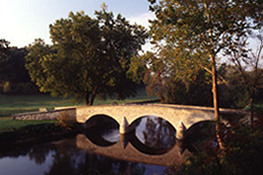
Battle of Antietam fought (September 17).
|
1862 |
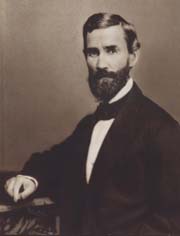 Samuel
Snowden Maffit becomes the seventh comptroller of Maryland and serves
from January 8, 1862 to January 13, 1864. Samuel
Snowden Maffit becomes the seventh comptroller of Maryland and serves
from January 8, 1862 to January 13, 1864. |
| Gov. Bradford declares third state constitution adopted on October
29 after soldiers' vote is added to election totals. Soldiers' vote
assures adoption of 1864
constitution, which abolishes slavery (effective Nov. 1) and requires strict loyalty oath of voters. A test oath is required of all voters. Maryland slaves are emancipated by state the new constitution on Nov. 1. Article 8 of the new constitution provides for a uniform, centralized system of tax-supported public schools. Property owners pay ten cents on each one hundred dollars of assessed value to a state school fund that the state begins to distribute to the counties and Baltimore according to school-age population. County commissioners and Baltimore City commissioners hire teachers, choose textbooks, and build schoolhouses. Freedmen's Bureau opens schools for former slaves.
|
1864 |
The comptroller's term is shortened to two years by Article 6, section 2 of the new constitution. The Board of Public Works as we know it today is established.
Robert John Jump becomes the ninth comptroller of Maryland and serves from November 26th, 1864 to January, 9 1867. |
|
Chapter 160 of the Acts of 1865 is passed providing for the first time a uniform system of free public schools for the State of Maryland under a State Board of Education. Due to a rising demand for oysters, the General Assembly passes a law (Chapter 181, Acts of 1865) permitting oyster dredging for bona fide Maryland residents but only under sail (using tongs or rakes; not scoop, drag, or dredge) in waters not less than 15 feet deep (Virginia watermen had been catching oysters in Maryland's part of the Chesapeake Bay; they were using dredges that damaged the oyster beds). See also Alan M. Wilner, The Maryland Board of Public Works: A History (Annapolis: The Hall of Records Commission, 1984), 66.
|
1865 | The comptroller is required to apportion the amount of school tax levied
among the counties and Baltimore City in proportion to their respective
populations between the ages of five and twenty.
The comptroller is to have blank oyster licenses printed and is to issue
licenses for oyster vessels.
|
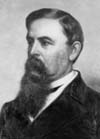 Thomas
Swann becomes governor and serves from 1866 to 1869. Thomas
Swann becomes governor and serves from 1866 to 1869. |
1866 | - |
| Fourth state constitution is adopted for Maryland by voters. | 1867 |
The comptroller's term is lengthened again to the current four-year term. The constitution places no limitation on the number of terms the comptroller can serve (Md. Const. 1867, Art. 6, sec. 1).
|
|
State oyster police authorized. |
1868 | - |
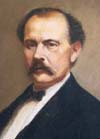 Oden
Bowie becomes governor and serves from 1869 to 1872. Oden
Bowie becomes governor and serves from 1869 to 1872. |
1869 | - |
Early 1870s-- A few Maryland fishermen begin selling crabs for their
meat (Brugger, 322).
 |
1870 |
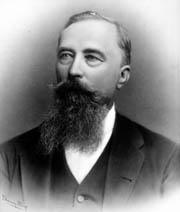 Levin
James Woolford becomes the eleventh comptroller of Maryland and serves
from January 17, 1870, to January 22, 1878. Levin
James Woolford becomes the eleventh comptroller of Maryland and serves
from January 17, 1870, to January 22, 1878. |
 Former
comptroller William
Pinkney Whyte becomes Former
comptroller William
Pinkney Whyte becomes
governor and serves from 1872 to 1874. General Assembly mandated separate but equal white and black schools. Western Maryland Railroad completed line, Hagerstown to Baltimore. |
1872 | - |
|
Maryland undergoes an economic depression. |
1873 | The comptroller plays a role in aiding farmers and jobless workers. |
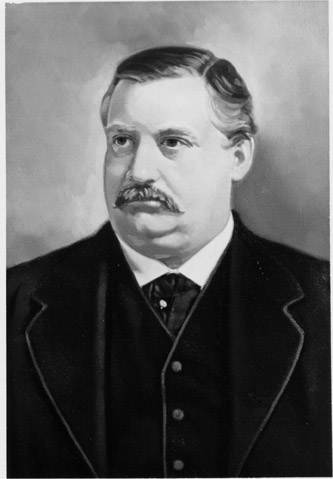
James Black Groome becomes governor and serves from 1874 to 1876. Commissioners of Fisheries authorized.
|
1874 | - |
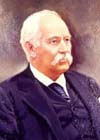
John Lee Carroll becomes governor and serves from 1876 to 1880.
|
1876 | - |
|
Baltimore and Ohio Railroad strike; workers went on strike along line, demonstrated in Cumberland, struck and rioted at Baltimore (July 20-22). |
1877 | - |
| - | 1878 |
Thomas James Keating becomes the twelfth comptroller of Maryland and serves from January 22, 1878 to January 22, 1884. |
|
Telephone exchange opened in Baltimore, first in State. |
1879 | - |
|
Bounty taxes are repealed.
|
1880 | - |
|
Chesapeake and Potomac Telephone Company formed. |
1883 | - |
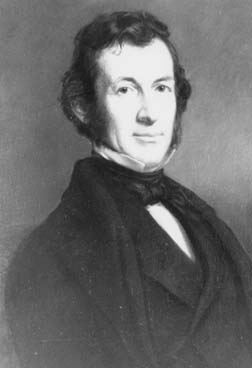 Robert
M. McLane becomes governor and serves from 1884 to 1885. Robert
M. McLane becomes governor and serves from 1884 to 1885. |
1884 |
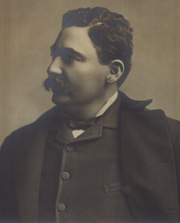 J.
Frank Turner becomes the thirteenth comptroller of Maryland and serves
from January 22, 1884 to January 16, 1888. J.
Frank Turner becomes the thirteenth comptroller of Maryland and serves
from January 22, 1884 to January 16, 1888.
J. Frank Turner becomes second Annapolitan behind the governor
|
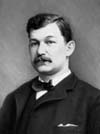 Henry
Lloyd becomes governor and serves from 1885 to 1888. Henry
Lloyd becomes governor and serves from 1885 to 1888. |
1885 | - |
 Elihu
E. Jackson becomes governor and serves from 1888 to 1892. Elihu
E. Jackson becomes governor and serves from 1888 to 1892.
Oyster Wars fought between Maryland and Virginia watermen
|
1888 |  L.
Victor Baughman becomes the fourteenth comptroller of Maryland and
serves from January 16, 1888 to January 19, 1892. L.
Victor Baughman becomes the fourteenth comptroller of Maryland and
serves from January 16, 1888 to January 19, 1892. |
|
Maryland begins use of secret ballot in elections. |
1890 | - |
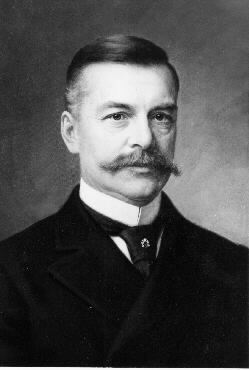 Frank
Brown becomes governor and serves from 1892 to 1896. Frank
Brown becomes governor and serves from 1892 to 1896. |
1892 |
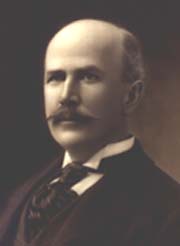 Marion
DeKalb Smith becomes the fifteenth comptroller of Maryland and serves
from from January 19, 1892 to January 21, 1896. Marion
DeKalb Smith becomes the fifteenth comptroller of Maryland and serves
from from January 19, 1892 to January 21, 1896. |
|
First child labor law passed; first pure milk law passed. |
1894 | - |
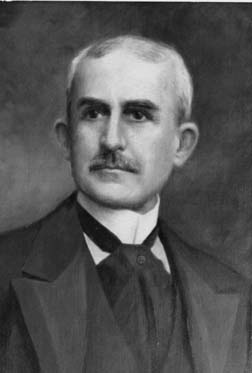
Lloyd Lowndes becomes governor and serves from 1896 to 1900. Maryland adopts improved "secret" ballot. |
1896 |
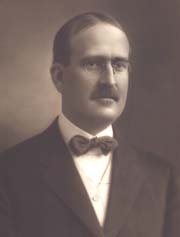 Robert
P. Graham becomes the sixteenth comptroller of Maryland and serves
from January 21, 1896 to January 18, 1898. Robert
P. Graham becomes the sixteenth comptroller of Maryland and serves
from January 21, 1896 to January 18, 1898. |
| - | 1898 |
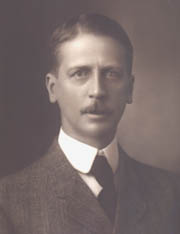 Phillips
Lee Goldsborough becomes the seventeenth comptroller of Maryland and
serves from January 18, 1898 to January 15, 1900. Phillips
Lee Goldsborough becomes the seventeenth comptroller of Maryland and
serves from January 18, 1898 to January 15, 1900. |
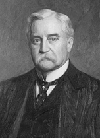 John
Walter Smith becomes governor and serves from 1900 to 1904. John
Walter Smith becomes governor and serves from 1900 to 1904. |
1900 |
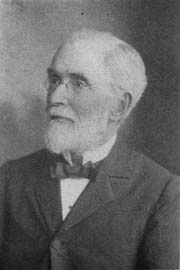 Joshua
W. Hering becomes the eighteenth comptroller of Maryland and serves
from January 15, 1900 to January 19, 1904 and again from January 20, 1908
to June 1, 1910. Joshua
W. Hering becomes the eighteenth comptroller of Maryland and serves
from January 15, 1900 to January 19, 1904 and again from January 20, 1908
to June 1, 1910. |
|
Election law replaced symbols on ballots with words. |
1901 | - |
| - | 1903 |
The comptroller's office moves to the newly-completed Court of Appeals building on Bladen Street between College Avenue and State circle, Annapolis (today the site of the Legislative Services building). The comptroller's office remains there until December, 1939. Robert
Shriver vs. Joshua W. Hering, Comptroller of the State of Maryland,
Court of Appeals of Maryland, 97 Md. 19 is decided. The court decides
that the comptroller must use the same method to calculate the apportionment
of school tax money for both
|
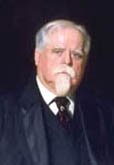 Edwin
Warfield becomes governor and serves from 1904 to 1908. Edwin
Warfield becomes governor and serves from 1904 to 1908. |
1904 |
 Gordon
T. Atkinson becomes the nineteenth comptroller of Maryland and serves
from January 19, 1904 to January 20, 1908. Gordon
T. Atkinson becomes the nineteenth comptroller of Maryland and serves
from January 19, 1904 to January 20, 1908. |
|
Voters defeat black-disenfranchising Poe amendment (November). |
1905 | - |
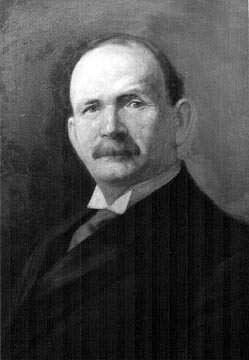 Austin
L. Crothers becomes governor and serves from 1908 to 1912. Austin
L. Crothers becomes governor and serves from 1908 to 1912.
Wave of campaign and election reform enacted, including primary elections.
|
1908 |  Joshua
W. Hering serves a second term as comptroller from January 20, 1908
to June 1, 1910. Joshua
W. Hering serves a second term as comptroller from January 20, 1908
to June 1, 1910. |
| - | 1910 |
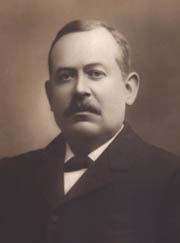 William
B. Clagett becomes the twenty-first comptroller of Maryland and serves
from June 1, 1910 to July 25, 1911. William
B. Clagett becomes the twenty-first comptroller of Maryland and serves
from June 1, 1910 to July 25, 1911. |
| - | 1911 | 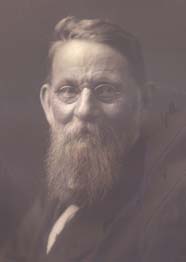 Charles
H. Stanley becomes the twenty-second comptroller of Maryland and serves
from August 2, 1911 to January 15, 1912. Charles
H. Stanley becomes the twenty-second comptroller of Maryland and serves
from August 2, 1911 to January 15, 1912. |
 Phillips
Lee Goldsborough becomes governor and serves from 1912 to 1916. Phillips
Lee Goldsborough becomes governor and serves from 1912 to 1916. |
1912 |
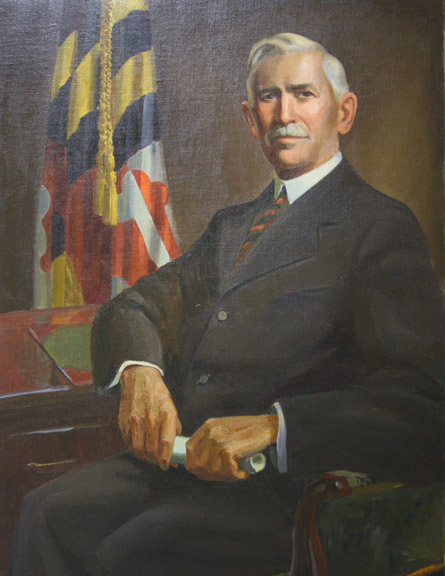 Emerson
C. Harrington becomes the twenty-third comptroller of Maryland and
serves from January 15, 1912, to January 10, 1916. Emerson
C. Harrington becomes the twenty-third comptroller of Maryland and
serves from January 15, 1912, to January 10, 1916. |
|
State Tax Commission established. |
1914 | - |
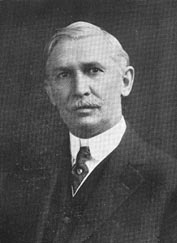 Emerson
C. Harrington becomes governor and serves from 1916 to 1920. Emerson
C. Harrington becomes governor and serves from 1916 to 1920. |
1916 |
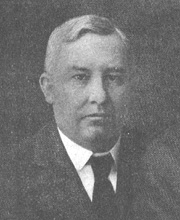 Hugh
A. McMullen becomes the twenty-fourth comptroller of Maryland and serves
from January 10, 1916 to January 19, 1920. Hugh
A. McMullen becomes the twenty-fourth comptroller of Maryland and serves
from January 10, 1916 to January 19, 1920. |
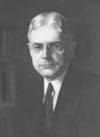 Albert
C. Ritchie becomes governor and serves from 1920 to 1935. Albert
C. Ritchie becomes governor and serves from 1920 to 1935.
First election in which women can vote. Central Purchasing Bureau reforms State expenditures. University of Maryland unites agricultural college and Baltimore professional
schools.
|
1920 |
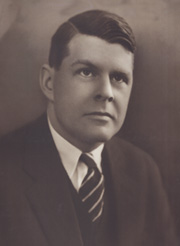 E.
Brook Lee becomes the twenty-fifth comptroller of Maryland and serves
from January 19, 1920 to January 19, 1922. E.
Brook Lee becomes the twenty-fifth comptroller of Maryland and serves
from January 19, 1920 to January 19, 1922. |
| - | 1922 |
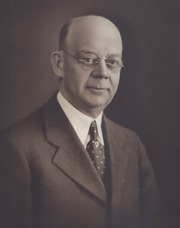 William
S. Gordy becomes the twenty-sixth comptroller of Maryland and serves
from January 19, 1922 to January 16, 1939. William
S. Gordy becomes the twenty-sixth comptroller of Maryland and serves
from January 19, 1922 to January 16, 1939.
Motor fuel tax is enacted at 1 cent per gallon. Equalization of school spending among counties is authorized.
|
|
Governor Albert C. Ritchie campaigns for Democratic presidential nomination. |
1924 | Motor fuel tax is increased to 2 cents per gallon. |
|
Baltimore City equalizes pay for black and white teachers. |
1926 | - |
|
Maryland passes legislation protecting the blue crab (ch. 368, Acts of 1927). Maryland-National
Capital Park and Planning Commission is formed.
|
1927 | Comptroller manages license fees and fines along with a Conservation Commissioner. |
|
Unemployed veterans march through Maryland as the "Bonus army." |
1932 | - |
|
|
1933 |
Alcoholic beverage tax is enacted on distilled spirits that are not over 100 proof. Tax rate is set at $1.10 per gallon. Motor vehicle titling tax is enacted at 1%.
|
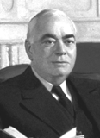 Harry
W. Nice becomes governor and serves from 1935 to 1939. Harry
W. Nice becomes governor and serves from 1935 to 1939.
Hall of Records opens, Annapolis. University of Maryland School of Law opens to blacks after NAACP lawyer Thurgood Marshall represents Murray in Murray v. Pearson County welfare boards are authorized.
|
1935 | Retail merchants deny the validity of the gross receipts tax law which
Comptroller Gordy must carry out.
Direct inheritance tax enacted at 1%. Gross receipts tax law of 1935 passed (Chapter 188 of 1935) |
|
Unemployment insurance law is enacted - rate of 2.7% of covered wages. |
1936 | The gross receipts tax law is not renewed. |
| - | 1937 |
Individual income tax enacted at one-half of one percent (.5%) (Ch. 11, Acts of 1937) Corporate income tax enacted at one-half of one percent (.5%)
Recordation tax enacted at one-tenth of one percent (.1%)
|
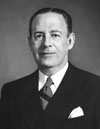 Herbert
R. O'Conor becomes governor and serves from 1939 to 1947. Herbert
R. O'Conor becomes governor and serves from 1939 to 1947. |
1939 |
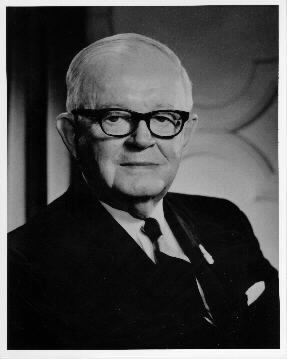 J.
Millard Tawes becomes the twenty-seventh comptroller of Maryland and
serves from January 16, 1939 to January 20, 1947. Tawes began a second
term as comptroller by appointment on July 5, 1950 and served until
January 14, 1959. J.
Millard Tawes becomes the twenty-seventh comptroller of Maryland and
serves from January 16, 1939 to January 20, 1947. Tawes began a second
term as comptroller by appointment on July 5, 1950 and served until
January 14, 1959.
In December, 1939, the comptroller and treasurer move their offices
to the new State Office Building (later the James Senate Office Building)
on College Avenue between Northwest and Bladen streets, Annapolis.
|
|
Maryland's 29th Division is at Omaha Beach for D-Day (June 6). |
1944 | - |
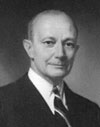 William
Preston Lane, Jr. becomes governor and serves from 1947 to 1951. William
Preston Lane, Jr. becomes governor and serves from 1947 to 1951.
|
1947 |
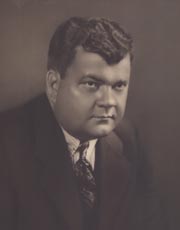 James
J. Lacy becomes the twenty-eighth comptroller of Maryland and serves
from January 20, 1947 to July 1, 1950. James
J. Lacy becomes the twenty-eighth comptroller of Maryland and serves
from January 20, 1947 to July 1, 1950.
Retail sales tax is enacted at 2%. Motor fuel tax is increased to 5 cents per gallon.
|
| - | 1950 |  J. Millard Tawes begins a second term as comptroller and serves from
July 5, 1950 until January 14, 1959.
J. Millard Tawes begins a second term as comptroller and serves from
July 5, 1950 until January 14, 1959. |
 Theodore
R. McKeldin becomes governor and serves from 1951 to 1959. Theodore
R. McKeldin becomes governor and serves from 1951 to 1959.
|
1951 | - |
Chesapeake Bay Bridge opens |
1952 |
-
|
| - | 1953 |
Franchise tax on savings institutions is enacted. |
| - | 1955 |
Employer withholding of income tax from wages instituted. Corporate income tax is raised to 5%.
|
|
Voting machines are first used for elections in Maryland. |
1956 | - |
| - | 1958 |
Individual income tax rate is increased to 3%. Cigarette tax is enacted at a rate of 3 cents per pack.
|
 Former comptroller J.
Millard Tawes becomes governor and serves from 1959 to 1967.
Former comptroller J.
Millard Tawes becomes governor and serves from 1959 to 1967.
|
1959 |
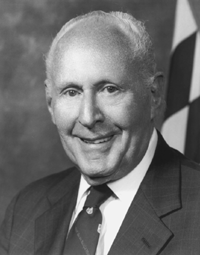 Louis
L. Goldstein becomes the thirtieth comptroller of Maryland and serves
from January 14, 1959 to July 3, 1998. Louis
L. Goldstein becomes the thirtieth comptroller of Maryland and serves
from January 14, 1959 to July 3, 1998.
Retail sales tax is increased to 3%.
|
| - | 1960 |
1960 House Resolution No. 18 is given to Comptroller Louis L. Goldstein for his service to the citizens of Maryland in providing greater assistance to taxpayers and creating a more efficient Comptroller's office. |
| - | 1964 |
Motor fuel tax increased to 7 cents per gallon.
|
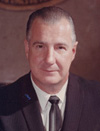 Spiro
T. Agnew becomes governor and serves from 1967 to 1969. Spiro
T. Agnew becomes governor and serves from 1967 to 1969. |
1967 | - |
| - | 1968 |
Corporate income tax is raised to 7%. Retail sales tax is increased to 4%. Motor Vehicle Titling Tax is increased to 4%. Income Tax is changed to graduated tax with 5% maximum tax rate.
|
 Marvin
Mandel becomes governor and serves from 1969 to 1977. Marvin
Mandel becomes governor and serves from 1969 to 1977. |
1969 | - |
|
- |
1970 | Transfer tax is imposed on instruments conveying title to real property. |
|
State Equal Rights Amendment adopted; Maryland ratified the federal ERA. First election in which 18 was the minimum voting age.
|
1972 | Motor fuel tax increased to 9 cents per gallon. |
|
Lottery is reenacted in Maryland. |
1973 | Cigarette tax increased to 10 cents per pack. |
|
Maryland celebrates the bicentennial anniversary of the founding of the U.S. |
1976 |
The comptroller's office unveils STARS, the computerized statewide accounting and reporting system, whose success would result in ten other states using a similar system of accounting by 1986. |
 Blair
Lee III becomes acting governor and serves from 1977 to 1979. Blair
Lee III becomes acting governor and serves from 1977 to 1979. |
1977 | Retail sales tax increased to 5%. |
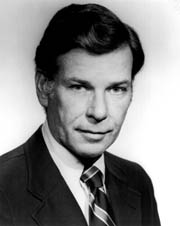 Harry R. Hughes becomes governor and serves from 1979 to 1987.
Harry R. Hughes becomes governor and serves from 1979 to 1987. |
1979 | Maryland becomes one of three states to earn the Certificate of Achievement for Excellence in Financial Reporting from the Government Finance Officers Association (GFOA). Maryland recieves this award every year for the next twenty years and beyond. |
| - | 1981 |
Early to mid-1980s: Maryland is one of three states in the country to win the coveted Certificate of Conformance awarded by the Municipal Finance Officers Association of the United States and Canda. Agricultural land transfer tax created. Motor fuel tax increased to 11 cents per gallon. Cigarette tax increased to 13 cents per pack.
|
| Taxing authority of State Athletic Commission extended to pay-per-view for boxing and wrestling. | 1984 |
The Treasury Building in Annapolis is renamed the "Louis L. Goldstein Treasury Building" in recognition of Goldstein's seven terms as comptroller. Motor fuel tax increased to 13.5 cents cent per gallon.
|
| - | 1986 |
Comptroller Goldstein receives the Distinguished Leadership Award from the Association of Government Accountants. Comptroller Goldstein addresses the National Association of State Comptrollers to announce Maryland's decision to use an outside, independent firm to conduct an annual audit of the state's accounts. |
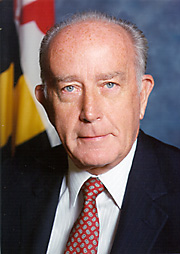 William
Donald Schaefer becomes governor and serves from 1987 to 1995. William
Donald Schaefer becomes governor and serves from 1987 to 1995. |
1987 | Motor fuel tax increased to 18.5 cents per gallon. |
| - | 1989 |
Comptroller Goldstein accepts the prestigious Donald L. Scantlebury federal award from the Joint Financial Management Improvement Program for outstanding leadership and improvements in financial management. Goldstein is credited with having improved financial reporting, preserved the integrity of the state's retirement system, improving cash management, maintaining Maryland's triple A general obligation bond rating, and developing a computerized statewide accounting system. |
| - | 1992 |
Cigarette tax increased to 36 cents per pack Motor fuel tax increased to 23.5 cents per gallon for gasoline.
|
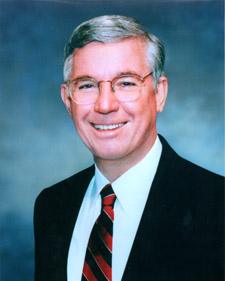 Parris
N. Glendening becomes governor and serves from 1995 to 2003. Parris
N. Glendening becomes governor and serves from 1995 to 2003. |
1995 | - |
| - | 1996 |
Louis Goldstein announces that he will seek an unprecedented 11th term as comptroller. The National Association of State Comptrollers issues a new award in
Goldstein's honor, the "Louis L. Goldstein Award for Excellence."
|
| - | 1997 |
Income tax is decreased to a maximum rate of 4.875%. |
|
- |
1998 |
 Louis
L. Goldstein dies on July 3 at his home in Prince Frederick, Calvert
County after serving almost forty years as Maryland's comptroller. Louis
L. Goldstein dies on July 3 at his home in Prince Frederick, Calvert
County after serving almost forty years as Maryland's comptroller.
At the time of Goldstein's death in 1998, final preparations are underway to allow Maryland citizens to file personal income tax returns electronically for the first time.
|
|
- |
1999 |
 William
Donald Schaefer becomes the thirty-second comptroller of Maryland and serves from January 25, 1999 to January 22, 2007. William
Donald Schaefer becomes the thirty-second comptroller of Maryland and serves from January 25, 1999 to January 22, 2007.
Schaefer announces that Maryland state residents can file their state tax returns electronically from their home computer for the first time. Maryland's comptroller's office becomes one of the first state agencies in the country to use federal data for state tax compliance programs. The comptroller's office initiates a program that results in the collection of more than $2.5 million in delinquent tax dollars by 2001. The comptroller's office initiates a program to better enforce and collect
Maryland's five percent use tax on out-of-state purchases such as
tobacco and furniture. The effort results in almost $121,000 collected
for fiscal year 2000 in cigarette taxes alone.
|
| - | 2000 |
Comptroller Schaefer, recognizing the potential problems of the "Y2K" computer bug for state computer systems, works to ensure that Maryland is among the first states to be prepared for the year 2000. |
| - | 2001 |
The Maryland General Assembly passes legislation making Maryland one of 20 states committed to implementing a streamlined system of collecting internet sales tax. Comptroller Schaefer launches an initiative to expand and improve the
services his agency provides to Maryland's local governments in areas of
revenue collection and distribution and fiscal reports.
|
| 2002 |
The comptroller's office launches its 150th anniversary celebration on February 24th. |
|
| Robert L. Ehrlich, Jr., becomes governor and serves from 2003 to 2007. | 2003 | |
| Martin J. O'Malley becomes governor and serves from 2007 to 2015 | 2007 | Peter V.R. Franchot becomes the thirty-third comptroller of Maryland on January 22nd. |
| Lawrence J. Hogan, Jr., becomes governor and serves from 2015 to 2023. | 2015 | |
| Wes Moore becomes governor on January 18, 2023. | 2023 | Brooke E. Lierman becomes the thirty-fourth comptroller of Maryland on January 16, 2023. She is the first woman to be elected to this position. |
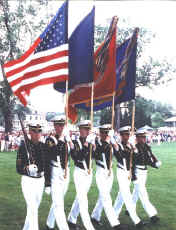 The
naval school at Fort Severn, Annapolis, becomes the United States Naval
Academy.
The
naval school at Fort Severn, Annapolis, becomes the United States Naval
Academy.
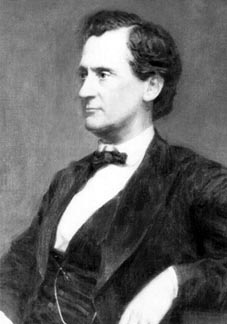
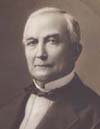
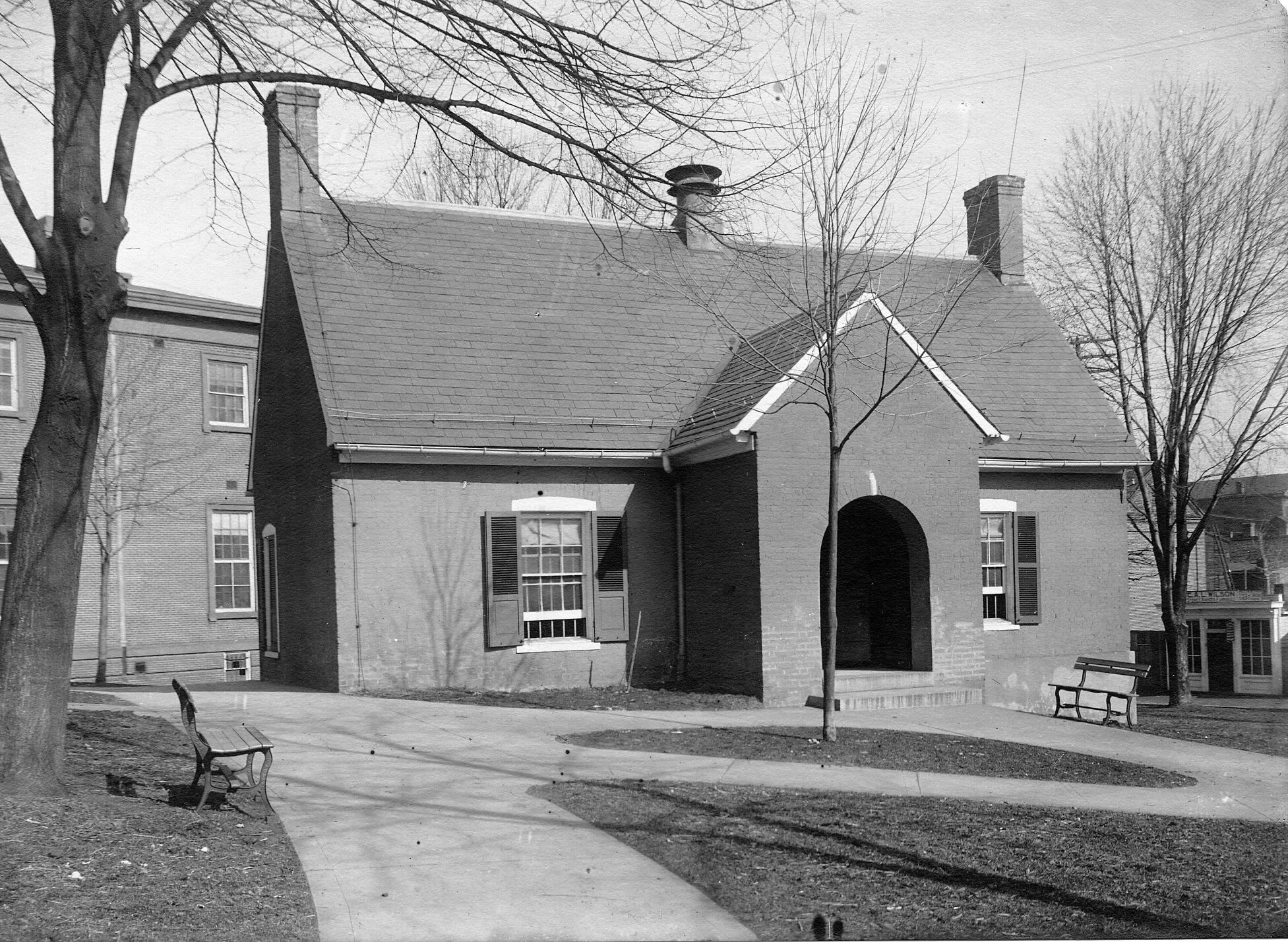
 President Abraham Lincoln suspends writ of habeas corpus in Maryland (April
27).
President Abraham Lincoln suspends writ of habeas corpus in Maryland (April
27).
 Riots
break out in Baltimore between
Riots
break out in Baltimore between
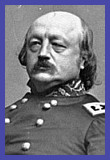 Gen. Benjamin F. Butler's Union forces occupy Baltimore
Gen. Benjamin F. Butler's Union forces occupy Baltimore
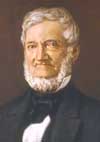
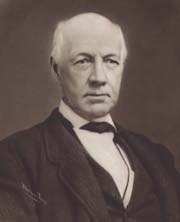
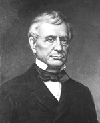
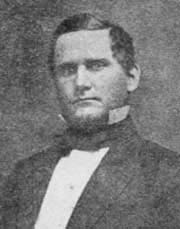
 John Wilkes Booth assassinates President Lincoln, escapes through Prince
George's and Charles counties (April).
John Wilkes Booth assassinates President Lincoln, escapes through Prince
George's and Charles counties (April).
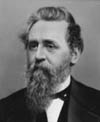
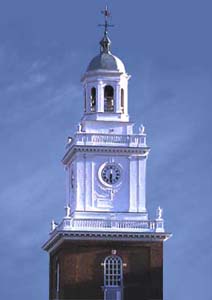
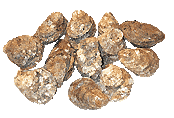 Oysters
from the Chesapeake Bay become a fruitful revenue source.
Oysters
from the Chesapeake Bay become a fruitful revenue source.
